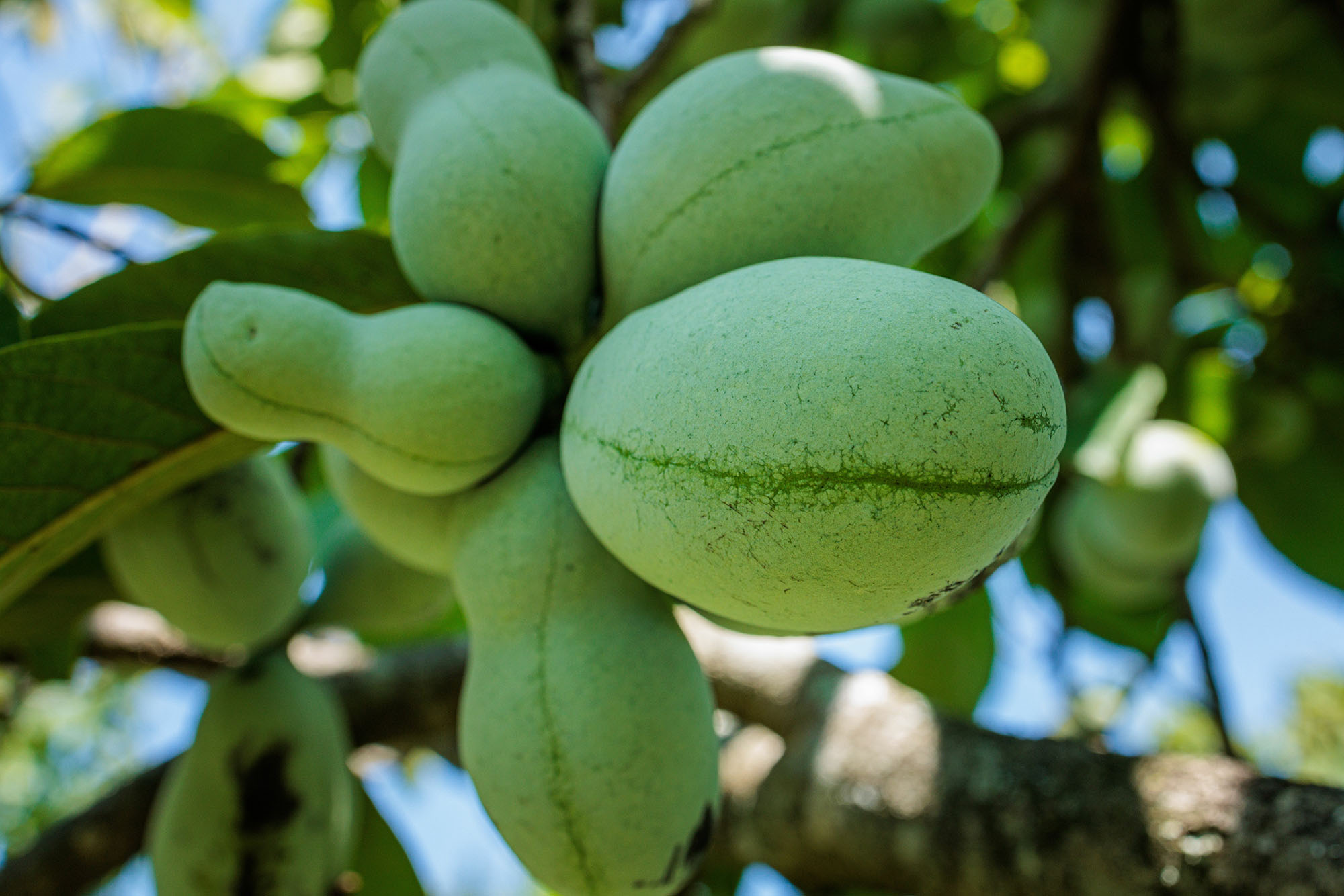- © 2025 Annapolis Home Magazine
- All Rights Reserved
By Kymberly Taylor

If you take a stroll in the woods this November, keep an eye out for the common pawpaw, Asimina triloba. Native to Maryland and the eastern United States, this fascinating tree is quietly beautiful, with giant tear-shaped leaves that face downward and “drip-tips” that channel rainwater to the ground. It produces the largest fruit indigenous to North America (besides squash, which is classified in botany as a fruit).
Though the pawpaw is relatively obscure, it is celebrated in local foraging and organic farming communities for its ecological resilience and creamy custard-like fruit. Pawpaw festivals take place in Frederick and rural Maryland during its harvest in September, where you may find pawpaw bread, pies, milkshakes, ice cream, jam, and even pawpaw beer and brandy.
You would never know this unassuming tree is an evolutionary wonder. Its fruits and giant seeds are a physical record of our prehistoric world. We can read our past in its leaves. Scientists, through fossil dating, believe the pawpaw developed about 5.5 million or more years ago during the Miocene epoch and evolved from a tropical plant family that existed far earlier when dinosaurs roamed the earth.
During the Miocene era, as the earth gradually cooled, many arid land grasses and plant species coevolved with various grass and fruit-feeding megafauna, including mammoths, mastodons, and giant land sloths. Ecologist and evolutionary biologist Roger E. Latham, Ph.D., believes these huge creatures ate the pawpaw and deposited their seeds as they migrated seasonally north and south. “It is really a living fossil,” he says. Later, its seed dispersers included early Native Americans, who ate the pawpaw and traveled with its seed, planting small groves for sustenance, according to pawpaw researcher Andrew Moore.
Unlike any other members of its plant family, the resilient pawpaw can weather severe cold. They propagate not only by seed but also by forming dense clonal patches, sending out numerous root suckers that send up new trunks.
What’s more, this feisty flora has an unusual strategy for fertilization. Because it predates the evolution of bees and butterflies, it relies on ancient pollinators. Flies and beetles are attracted to its burgundy blooms that, by nature’s design, smell like fermented fruit, explains Latham. “The plant makes a chemical that imitates the yeast present in rotting fruit. Many insects have the ability to smell that and home in on it.”
Some brave pawpaw gardeners hang roadkill in its branches to lure these winged scavengers. Luckily, this is not necessary, says farmer Jim Davis, who has owned Deep Run Pawpaw Orchard in Westminster for 30 years. He relies on the tiny fungus gnat, which is attracted to pawpaws blooming in late April. “I can hear them out there humming if the weather’s nice,” he says.
Aware of the pawpaw’s profound niche in our ecosystem, landscape architect Jay Graham has been humming its praises for many years. “It started slowly. I first met the pawpaw when I was in St. Louis, Missouri,” he reflects. Their botanical garden has an arboretum in the country. “I was walking in October across a stream, and the leaves had turned a bright yellow, and sun was coming through them. It was a beautiful moment.”
He returned to study the pawpaw, which was a staple for many Native American tribes, including Pawnee, Kanza, Cherokee, Cree, and Choctaw. When famous American explorers Lewis and Clark ran out of provisions in 1806, the delicious and abundant fruits saved them from starvation.
Graham began experimenting with the pawpaw, incorporating the slender trees into his landscape designs. One client in Annapolis wanted an avenue of trees opening to a grove and auto court. “I lined the driveway with pawpaws, creating a leafy vegetative tunnel,” says Graham.
Graham encourages homeowners to plant pawpaws in their landscapes, for they are deer-resistant, beautiful, and productive, providing shade, abundant foliage, long-lasting blossoms in the spring, and food for humans and small animals. And it is host to the rare and stunning zebra swallowtail butterfly, which would not exist in our climate without the pawpaw, says Latham. “Its caterpillars can eat only one thing: the young leaves of pawpaw in the spring.”
Pawpaws grow in sun and shade to about 25 feet and take about four to eight years to mature and seven years to bear fruit. Plant your pawpaws in full sun to encourage fruiting. Plant at least two pawpaws to encourage fruit production. Harvest when fruits are green but beginning to feel soft to the touch. Eat them within a few days; they have a very short shelf life. Or scoop out the pulp and freeze in ice cube trays, suggests Latham.
A landscape architect for over 40 years and a true plantsman, Graham has integrated the pawpaw into his daily life. He and his wife Dolores Dyson Engle nurture many saplings in their extensive gardens. One may find pulp in the freezer, and if you are lucky, discover some homemade pawpaw bread to share. Their love of the pawpaw does not stop there. Graham’s grandchildren fondly call him “Paw paw,” which makes the fruit a juicy part of the family tree.
Paw Paw Hill Farm: 614 Calvary Rd, Churchville, MD 21028
Whitetail Hill Chestnuts: whitetailhillchestnuts.com
© Annapolis Home Magazine
Vol. 15, No. 6 2024